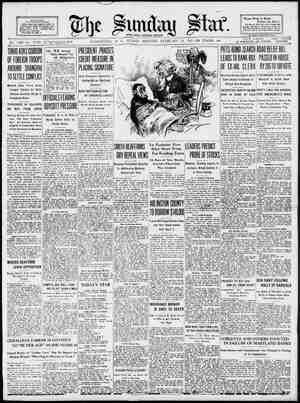Evening Star Newspaper, February 28, 1932, Page 74
You have reached the hourly page view limit. Unlock higher limit to our entire archive!
Subscribers enjoy higher page view limit, downloads, and exclusive features.
t Last THE SUNDAY STAR, WASHINGTON, D. @, FEBRUARY B DR a Mechanical Brain From a Yale University Laboratory Model May Come a Practical Electrical Apparatus That “Learns,” “Remembers” and ““Thinks,” Just as Human Brains Do, but Never. Makes an Error. BY D. LINDSAY WATSON. COLLECTION of coils, wires amd batteries, a sort of haywire radio set in appearance, is science’s Jatest me- chanical brain. Like a young child, #t can be taught. Like Paviov's famous dogs, whose mouths watered at the mere ringing of the dinner bell, this aggregation of lifeless electrical apparatus can be given “conditioned reflexes.” This mechanical brain is noét very practical. Its purpose is to help psychologists understand how the human mind works. It is a fraction of a Robot of science. This mechanical brain shows that there is no exact borderline between lifeless and dving things. It is a new kind of machine that does not blindly repeat, but can, in a sense, learn what it is taught. Other Robot devices are common in every- @ay life: Adding machines, bookkeeping ma- chines, typesetting machines, bottling machines, shoe-making machines, automatic looms, photo- electric cells that level elevators, control tem- perature, and switch lights on and off as day- light fades or dawns. Notice, however, that machines of this type do only the kinds of things that they are de- signed to do. They never learn anything new, of themselves. They are like men who are good at routine but show no imagination. new “conditioned reflex” machines, de- veloped under the direction of Prof. Clark L. Hull of Yale University, do not have this lmitation. Though they have not yet reached the stage of practical application, they give one something new and startling to think about. Collaborating with Professor Hull in making these were Dr. H. D. Baernstein, R. L. Krueger and G. K. Bennett. Two other inde- ~ pendent workers have also recently made simi- Jar machines. The special feature of these new machines 13 that they can be taught something that was not thought of when they were being designed. They are not, it is true, as dexterous as a dial telephone exchange, but it will take only time to make them more nearly perfect. Several different forms of these “learning” models have been made. The simplest of these, invented by R. L. Krueger, depends chiefly on what are called “polarizable electrolytic cells.” Such a cell s very much like the storage battery of your automobile. It will give out current after a charging current has been passed through it, but none at all before it bhas been charged for a first time. Mr. Krueger's storage cells are small and easily charged and discharged. He hooks them up in parallel and then connects the whole set in parallel with an electric bulb provided with s separate dry battery Yo light it. Switches are placed in the main circuit and in each of the storage cell circuits. The whole thing looks much simpler than Jumior's first radio set. What has this to do with Paviov's “cendi- tioned reflex”? 'I'H! scientific work of Prof. I. P. Paviov, of the Russian Institute of Experimental Med- feine in Leningrad, was recognized in 1904 by the award of a Nobel prize. By many his work subject of how man really thinks. _ Pavlov is primarily a physiologist and not a psychologist. Now a fundamental concept of physiology, introduced a long time ago by the philosopher Descartes, is that of “reflex.” Dry Ddattery, ing to ood stimulus m Palov's ex- periment. Light, illumj. noted when switch Is closed, gorresponding to k wotering of dog's tongue he is shown A diagran. of the “mechanical brain,” showing how it works. At the left are swo dry-cell batteries, ¢ the right a series of storage cells. originally um:harggd, to represent the five senses. Closing the switch at the lower left and the one at the righs {;:n:‘ :ah; ear” uc::?{le battery l;ghh: the lig’{uat‘ ar;i passes a current through the “ear” battery. If this is done several times store up a ¢ e so that the light be lit si i 7 o i - “m"bateryfrom vy vacis™ f . gopen. ght can be lit simply by closing the switch from the “ear” and leaving Automatically your hand draws Without any conscious intervention on your part the muscles of your arm come into play. Actually, when such a muscle moves it must receive & message from the central nervous system—that is, from the brain or mflbe message is carried to it A your hand reaches the cen! similarly along a nerve pathway. nent, inherited connection links the incom nerves from your fingers and the outg nerves of your arm. The whole mechanism by which the hand withdraws is called a reflex by physiclogists. reflex of food, saliva. All that is necessary for the forma such conditioned refiexes in the dog is that two stimuli be presented to the animal at same time when it is in a receptive mood. This particular “salivary” reflex is of para- mount interest, for it was made the basis by Paviov of his long series of experiments with dogs, which has brought him the acclamation of the whole scientific world. ‘The importance of a reflex for the psychol- ogist is *hat it can be observed without the necessity for making any guesses about what going the Electric switches whith The diagram above shows how the tc while, from either alome, can receive stimuli both from the eye and the ear, or, brain,” with George K. Bennett showing how it has
